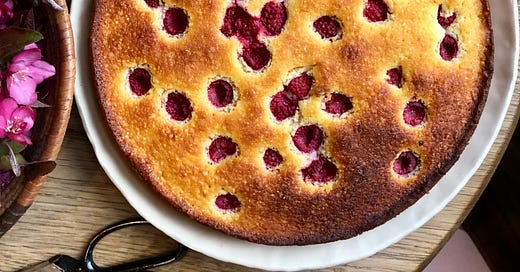I love polenta cake. Over the years I have made many different polenta cakes- some dense and gritty and maramlade-esque laden with whole pulverized citrus, some buttery, almondy and gluten free, and others, like this one, subtle, soft and very easy to eat a lot of. In all cases, the flavour of the polenta is lifted and carried by plenty of citrus.
To me, polenta cake is the most ideal way to enjoy tangy fruit in a cake. Citrus- especially lemon, lime, orange and kumquat- but also berries such as raspberries and blackberries, stonefruit- such as plums, apricots and peaches- and rhubarb to name a few. Passionfruit, is also surprisingly delicious baked into a polenta cake or served on the side with a dollop of good heavy cream or lightly sweetened yoghurt. As I can begin to feel summer slooooowly making her way to us, this is a good recipe to have on hand.
My favorite combinations for this particular polenta cake are: rhubarb, lemon and pine nuts (lay poached rhubarb on top and sprinkle over a couple of tablespoons raw pine nuts before baking); blackberry and orange; blueberry and lime; kumquat and almond (sub 1/2 of a cup of the flour for finely ground toasted almonds, add a cup of finely sliced kumquats and an extra 1/4 cup of sugar), roasted plum, almond and lemon (roast halved plums with a sprinkle of sugar until just softening, sub 1/2 cup of flour with finely ground roasted almonds); apricot, vanilla bean and lemon; peach, raspberry and lemon. And of course this version, raspberry and lemon, which is calm and classy with just enough zing.
A note on ingredients: Polenta is ground dried corn, also sold as corn grits in the US. Bob’s Red mill has one that I have used very successfully in baking, I think they may even have both names of the label which is helpful as I was very confused about this when I first moved here. It is NOT the same as Masa Harina (a mistake I also made when I first moved here!) which is dried corn that has been nixtamalized and very finely ground for making tortillas etc. I have made this with greek yoghurt, natural yoghurt and even buttermilk, they all work just fine, but if you do happen to use buttermilk, remove a couple of tablespoons from the recipe. You can remove or add a few tablespoons of sugar depending on your personal taste or the fruit you are using without affecting the chemistry too much, I like 1 1/3 c for most of my polenta cakes.
Keep reading with a 7-day free trial
Subscribe to Still Life With Lemon to keep reading this post and get 7 days of free access to the full post archives.





